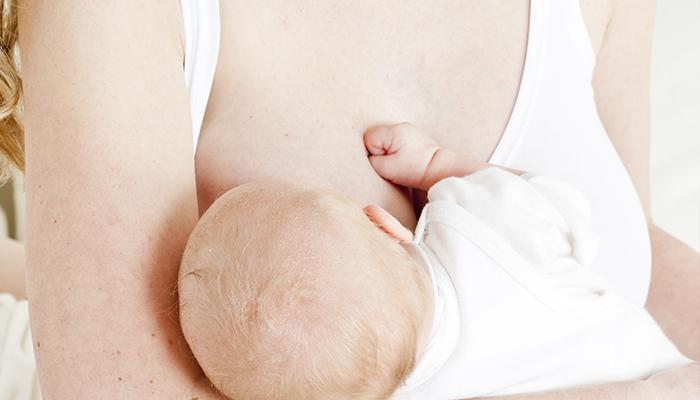Breastfeeding Basics
Posted by Lindsay Gibson on Sep 12th 2018
Oh, the breastfeeding blog – one that many might read openly or with only one eye open! I will cut to the chase before I dive into some breastfeeding basics to follow with breastfeeding – it is challenging!
 There is so much breastfeeding controversy out there with all kinds of social media arguments and information. It can leave a new mother confused, nervous and overwhelmed. She probably has heard terms all over the place such as “breast is best” or “fed is best”. Breastfeeding is both scientifically and mentally/emotionally proven to be best for babies. But, it is not something that is generally achieved with ease.
I personally have always wondered, if it is so natural - then why is it so difficult for many mothers to successfully breastfeed? The answer to that varies from mom to mom. As we all are learning to support one another, the best thing you can do to help another mother is to use no judgment with any choice she makes about breastfeeding.
There is so much breastfeeding controversy out there with all kinds of social media arguments and information. It can leave a new mother confused, nervous and overwhelmed. She probably has heard terms all over the place such as “breast is best” or “fed is best”. Breastfeeding is both scientifically and mentally/emotionally proven to be best for babies. But, it is not something that is generally achieved with ease.
I personally have always wondered, if it is so natural - then why is it so difficult for many mothers to successfully breastfeed? The answer to that varies from mom to mom. As we all are learning to support one another, the best thing you can do to help another mother is to use no judgment with any choice she makes about breastfeeding.
 Like with all things in motherhood, the biggest challenge while learning to breastfeed – is to give yourself a lot of grace along the way!
Also – just know that every mom you know might want to give you their breastfeeding stories, both good and bad, just like they might do about their birth experiences. Always know that your experience will not be exactly the same as theirs!
Yes, there are many stories and things to watch for about difficult latches, thrush, mastitis, cracked nipples or other problems associated with breastfeeding. But above it all, it is a learned art and sometimes a little help is needed during the learning process. As a new mother or a future new mother, you need to equip yourself with as much knowledge as possible. This will help ensure that your breastfeeding experience is successful from the very beginning.
Like with all things in motherhood, the biggest challenge while learning to breastfeed – is to give yourself a lot of grace along the way!
Also – just know that every mom you know might want to give you their breastfeeding stories, both good and bad, just like they might do about their birth experiences. Always know that your experience will not be exactly the same as theirs!
Yes, there are many stories and things to watch for about difficult latches, thrush, mastitis, cracked nipples or other problems associated with breastfeeding. But above it all, it is a learned art and sometimes a little help is needed during the learning process. As a new mother or a future new mother, you need to equip yourself with as much knowledge as possible. This will help ensure that your breastfeeding experience is successful from the very beginning.

 There is so much breastfeeding controversy out there with all kinds of social media arguments and information. It can leave a new mother confused, nervous and overwhelmed. She probably has heard terms all over the place such as “breast is best” or “fed is best”. Breastfeeding is both scientifically and mentally/emotionally proven to be best for babies. But, it is not something that is generally achieved with ease.
I personally have always wondered, if it is so natural - then why is it so difficult for many mothers to successfully breastfeed? The answer to that varies from mom to mom. As we all are learning to support one another, the best thing you can do to help another mother is to use no judgment with any choice she makes about breastfeeding.
There is so much breastfeeding controversy out there with all kinds of social media arguments and information. It can leave a new mother confused, nervous and overwhelmed. She probably has heard terms all over the place such as “breast is best” or “fed is best”. Breastfeeding is both scientifically and mentally/emotionally proven to be best for babies. But, it is not something that is generally achieved with ease.
I personally have always wondered, if it is so natural - then why is it so difficult for many mothers to successfully breastfeed? The answer to that varies from mom to mom. As we all are learning to support one another, the best thing you can do to help another mother is to use no judgment with any choice she makes about breastfeeding.
It starts with mom…
Yes, you mama – breastfeeding begins with you even prior to giving birth to your baby. This is because the psychological and emotional impact that you have towards breastfeeding goes a long way. Every mom is different. Some moms are highly motivated with a strong, positive mindset about breastfeeding before birth. While others are worried, anxious and scared. Does it mean that having a positive mindset will stop all the breastfeeding challenges? No, it doesn’t. But a positive mindset can help a mother to overcome the challenges better. More importantly, your baby can feel all of your worries and anxiety and when they're born, they can sense it even more. The best thing you can do for yourself if you are still pregnant, or even if you have already delivered, is to sit every day, hand on your chest and another on your heart, taking deep breaths and repeat the affirmation below (or one you like). Like with all things in motherhood, the biggest challenge while learning to breastfeed – is to give yourself a lot of grace along the way!
Also – just know that every mom you know might want to give you their breastfeeding stories, both good and bad, just like they might do about their birth experiences. Always know that your experience will not be exactly the same as theirs!
Yes, there are many stories and things to watch for about difficult latches, thrush, mastitis, cracked nipples or other problems associated with breastfeeding. But above it all, it is a learned art and sometimes a little help is needed during the learning process. As a new mother or a future new mother, you need to equip yourself with as much knowledge as possible. This will help ensure that your breastfeeding experience is successful from the very beginning.
Like with all things in motherhood, the biggest challenge while learning to breastfeed – is to give yourself a lot of grace along the way!
Also – just know that every mom you know might want to give you their breastfeeding stories, both good and bad, just like they might do about their birth experiences. Always know that your experience will not be exactly the same as theirs!
Yes, there are many stories and things to watch for about difficult latches, thrush, mastitis, cracked nipples or other problems associated with breastfeeding. But above it all, it is a learned art and sometimes a little help is needed during the learning process. As a new mother or a future new mother, you need to equip yourself with as much knowledge as possible. This will help ensure that your breastfeeding experience is successful from the very beginning.
Breastfeeding Basics
Let’s go over some basics!The Latch
The latch is one of the biggest obstacles to overcome. A well-latched baby will effectively massage your breasts and extract your milk – cueing your breasts to make more and more! The baby will regulate how much your milk will come in. This can often confuse many mothers, thinking they are not producing enough. Their breasts most likely are not being emptied well enough to make more.
Latch Tips
- Let the baby come to your breasts, not you putting the baby on them – this is a natural instinct that babies know how to do once they are put near the breast to search and find.
- Make sure a large amount of areola/breast tissue is in baby’s mouth.
- Baby’s chin should be firmly pressed against the breast and baby should be able to breathe freely through the nose.
- Always remember: breastfeeding is not nipple feeding!
- Babies don’t need much, especially in the beginning but they need it often – every two hours and be allowed to latch on as long as needed! You might need to wake them a lot in the beginning to latch.
Engorgement Tips
The first milk to come in is a yellow-thickish type of milk that is called colostrum a.k.a liquid gold. It's super rich in nutrients and antibodies and the perfect first meal for baby! Within five days or so, your milk will come in and for many, engorgement then becomes a challenge.- Despite how full and hard your breasts will all of a sudden feel – supply and demand is how to keep it going – so even though you may want to hold off from a feeding because of it or baby becomes a bit frustrated with how fast your let down is with the engorgement – don’t skip feedings! This will only worsen your engorgement.
- Warm showers hitting your chest and breasts can help soothe before a feeding or a warm compress for 5 – 10 minutes prior.
- After the feeding – apply a cold compress for about fifteen minutes to reduce inflammation.
- Lightly massage, while nursing, the hard lumps you feel in your breasts.
- Manually (or use an electric pump on low setting) extract some milk to soften the areola prior to a feed and lengthen your nipple so baby can latch properly to extract the rest.
Sore Nipple Tips
This one is always so hard for many mamas in the beginning! There are many nipple balms out there, we at Our Green House particularly like this one. Hopefully, that will be enough to help soothe you but if not, here are some more tips.- Free your breasts! Air drying and allowing your breasts to be free from bras and clothing after a feeding helps heal them. Apply a little breastmilk on each nipple and let it air dry.
- Need more? Try:
- 1 tablespoon apple cider vinegar, 1 cup of filtered water, raw coconut oil, powdered infant probiotics, and organic cotton balls.
- After each feeding – mix ACV and water and use a cotton ball to apply to each nipple (kills yeast and bacteria).
- Next, apply a small amount of coconut oil and sprinkle some probiotic powder on each nipple. Place a small piece of paper towel in-between your nipple and nursing bra. You can even use this combination as a preventative! (source: Natural Mama)
- If your nipples become cracked or bleeding and unbearable to nurse – find a pediatric dentist in your area to assess for lip or tongue tie if there are no lactation consultants available.
